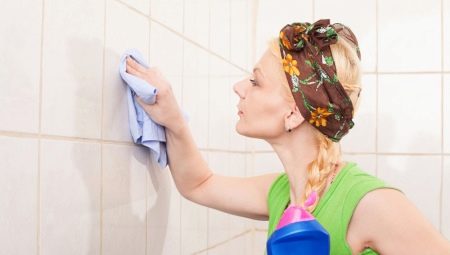A bathroom is a room that evokes associations with cleanliness and shine. However, this is not always the case. Many housewives are looking for information on how to wash the tiles in the bathroom from fungus and plaque, since these pollution spoil the whole impression of the room.
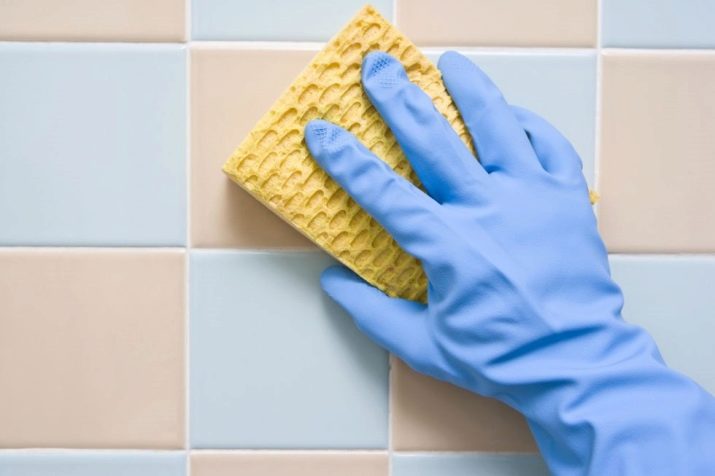
Causes of pollution
To cope with the pollution on the tile, you should familiarize yourself with the causes of their occurrence. Knowing all the nuances, you can quickly restore ceramics to their original appearance. The bathroom often uses water in which there is lime and a variety of salts. When these elements get on the tile, they leave stains, which later turn into lime. Eliminating this type of pollution is quite difficult.
Mold with fungus appears due to:
- high humidity;
- the presence of dirt in the joints between the tiles;
- constant contact with tap water;
- exposure to high temperatures;
- breeding bacteria;
- neglect of surface care.
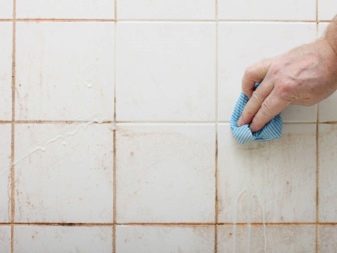
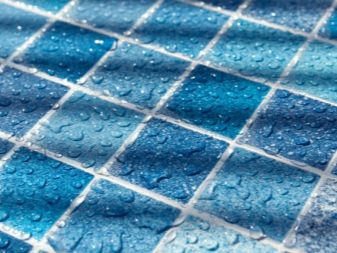
Funds
Tile cleaners in the bathroom are sold in many stores. The following products are popular:
- Cillit bang copes with limescale, rust. The special composition helps break down fat and give an attractive sheen to the surface.
- Domestos Help eliminate mold and all germs from the bathroom. It is most convenient to use a spray.
- Mr Muscle not only actively eliminates lime and soap scurries, but also helps to get rid of greasy traces and germs.
- Trademark Comet offers a wide selection of products that helps in cleaning the bathroom and other rooms. Using a spray you can quickly remove plaque, grease and dirt.
- Melamine sponge is an alternative to chemicals. The sponge consists of melamine foam, which penetrates the pores of the tiles and eliminates plaque and dirt.

Many housewives prefer to use home remedies, which are in almost every home. The following methods are considered the most popular:
- The combination of table vinegar and baking soda. These ingredients remove lime and salt in 10 minutes. Using table vinegar without soda will help you not only deal with dirt, but also get an attractive shine on the tile.
- Using citric acid, you can get rid of dirt on the tile. You will need to rub the surface with lemon juice or citric acid. After processing the walls should be wiped with warm water.
- Ammonium fights lime, fungi and mud. Keep in mind that this substance has an unpleasant odor; therefore, safety measures should be observed when using it. As a rule, this method is resorted to when cleaning the seams between the tiles.
Using folk methods, you can quickly and painlessly remove tiles from the tiles to remove various contaminants.

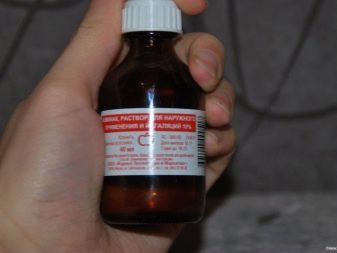
In addition to the list of recommended products, there is a list of substances that destroy the surface of the tile. Experts do not recommend using the following tools to clean the tiles in the bathroom:
- acidic detergents;
- abrasive products;
- brushes with rough teeth;
- metal washcloths;
- Do not clean the surface with powders intended for manual use;
- substances used in the dishwasher;
- products for cleaning furnaces and sinks;
- substances intended for the toilet.
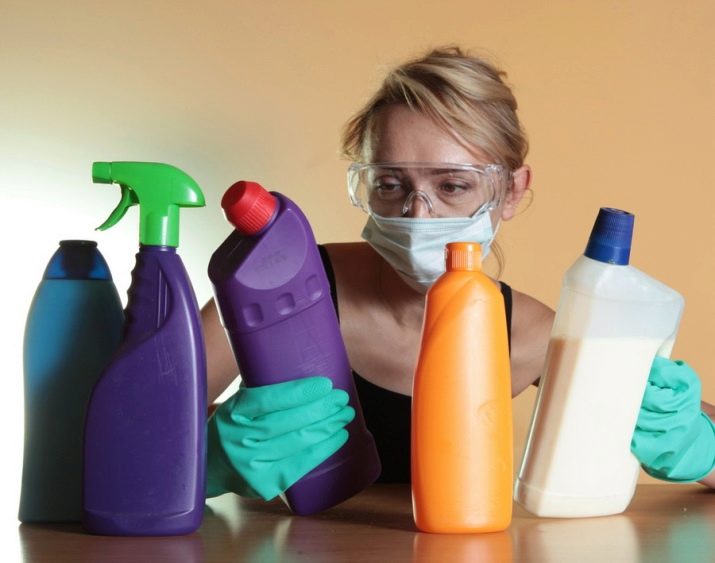
How to remove stains?
To remove stains from the tiles in the bathroom, you need to decide what pollution you plan to fight. There is an effective method for each type of stain. Many grab their heads after repairs in the bathroom, since sealant and rust marks seem, at first glance, an impossible task.
Limescale
Many housewives are faced with a problem when lime hits the surface of the tile, soaking into the grooves between the ceramics and into other cracks. With the help of purchased products, you can qualitatively clean the tiles until a mirror shine appears. The products are designed for various types of contaminants that attack the surface of not only walls, but also floors. Many products are added disinfectants that eliminate fungus and germs.

To clean the tile in the bathroom to a shine, pay attention to the composition of the substance.
Do not buy products that contain acids and cleaning agents. You also need to carefully study the instructions for using the selected drug. Gel-like products show the best result, as they are more convenient to use and more effective.
A good result in the fight against lime showed a tool for cleaning glasses with ammonia. You will need to spray the spray on the desired area, and then just wash the tiles on the wall.
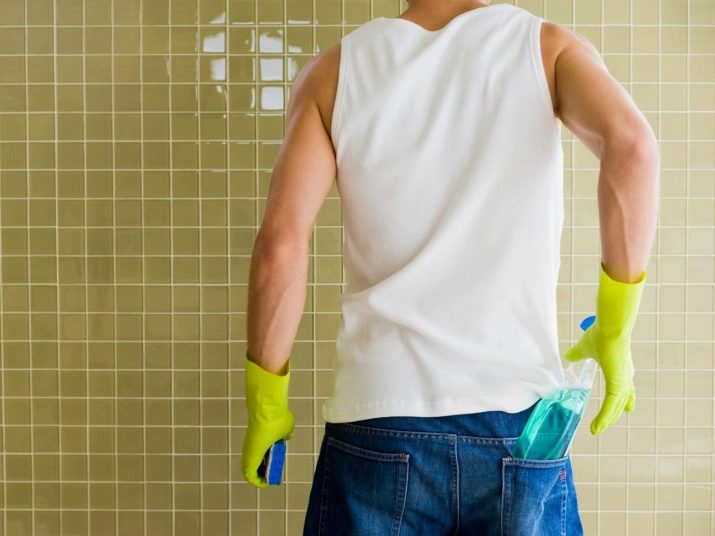
Grout
Many were faced with a situation where after repair on the tile there were traces of grouting. This type of contamination is easy to remove. Wait until the grout becomes lighter and wash the surface of the tile with water. When the layer becomes softer, it can be easily removed.
Epoxy is more difficult to remove. It is best to immediately use a special tool that is sold in the store.
To exclude such situations, use masking tape or film when grouting.
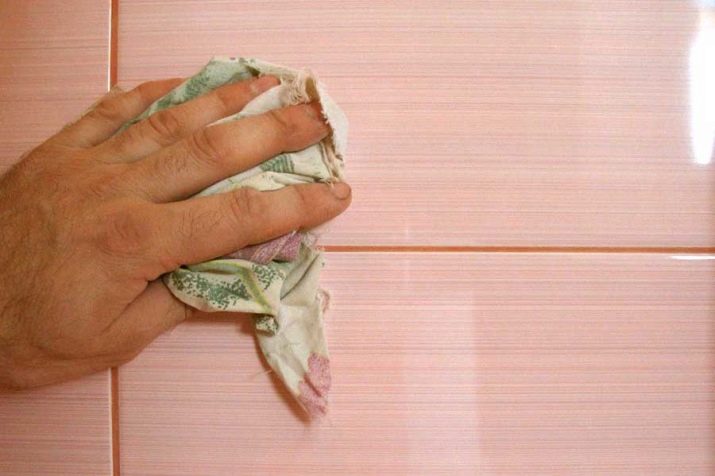
Sealant
To wipe off the sealant crust that has dried up after repair, you will have to try. To eliminate pollution, you can use the following methods:
- Try to remove the substance during masonry. For these purposes, you can use a rubber spatula or a damp cloth.
- If the sealant has already dried, ammonia or table vinegar is suitable for its elimination. Acetone is effective against the polymer mass, but cleaning the tiles in this case should be done carefully.
- Silicone removes solvent-based products well.
- Grinding can also be used to soften the sealant. Then use a spatula or a hard sponge.
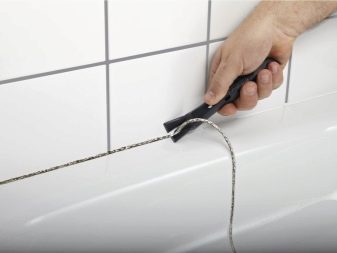
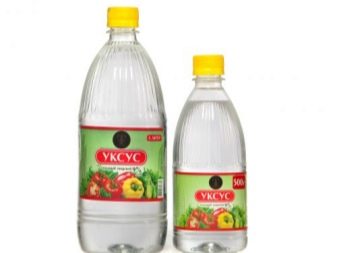
Ingrained dirt
In the bathroom, you should monitor not only the surface of the walls, but also the cleanliness of the floor. Its surface is also exposed to moisture, soapy water and other objects. Dirty floors are not only ugly, but also dangerous. Such a floor can even injure its owner, as it is easy to slip on it.
When working with floor tiles, you can use abrasive detergents. Unlike wall tiles, it is more resistant to abrasion. The following methods are also recommended:
- If light tiles are used on the floor, clean using warm water and a small amount of soda ash. One pinch is enough.
- Tiles of dark colors should be washed with warm water and a liquid detergent for floors.
- If the contamination is serious enough, dampen the floor and sprinkle its surface with soda, then rub it with a brush. After some time, vinegar can be sprayed. Substances are removed with a mop.
- There is an anti-slip coating on the floor tile, so it is recommended to immediately wipe the floor if water gets on it. By following this rule, it will be easier for you to restore the shine to the tile.

Welding
When replacing pipes in the bathroom, you may need a grinder. After its use, the tile is covered with black dots, which causes many housewives to panic. How to get rid of traces of welding on tiles:
- It is better to take care of such a situation in advance. Take preventative measures. Cover the area around the pipe with a cloth, securing the ends of the material with masking tape. Polyethylene should be discarded, since welding will burn such a surface.
- Frozen drops of metal can be removed with hydrochloric acid. Dilute the solution with a small concentration and apply it to the desired area for 10 minutes. Do not breathe acid fumes; this is hazardous to your health and carry out activities with gloves and a mask.
- At the end of the reaction, only iron salts will remain on the tile. They are easily washed with cold water. In place of the drops, only craters will remain, which it will not be possible to get rid of.
Based on these recommendations, care should be taken in advance to prevent the appearance of welding drops on the tile. In case of welding contact with the tile, you should immediately consider buying a new tile, since craters are very noticeable on a light glazed surface.

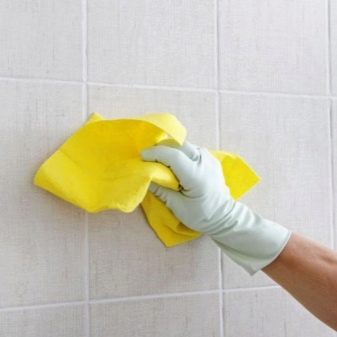
Rust
To remove rust from the tiles, you can use different cleaning methods:
- Cream of tartar. This substance is sold in powder form. To remove rust, sprinkle powder on the desired area and wipe it with a sponge moistened with water. To make the procedure faster, pre-treat the surface with 3% hydrogen peroxide.
- Vinegar and baking soda effective against rust. Work should be in rubber gloves. Moisten a sponge with 6% vinegar solution and generously sprinkle it with baking soda. When the two substances react, start processing the tiles.
- Lemon juice with salt effectively copes with rust on tiles. Juice can be replaced with citric acid. The necessary area should be moistened with plenty of juice and left for 25 minutes. Then sprinkle the surface with finely ground salt and use a circular motion to remove the rust spots. Use only table salt without crystals and stones.

Remove mold and fungus
Mold can affect not only the joints of tiles, but also the walls, ceiling in the room. It is necessary to fight the fungus at the initial stage, since such a formation carries harm to the human body.
Many brands produce special products that help eliminate blackness on the seams of tiles in the bathroom. However, the cost of such products is quite high. Alternatively, you can use budgetary methods to eliminate the fungus:
- The steam cleaner perfectly destroys microbes, fights grease, dirt and mold.
- With the help of "White" or bleach, you can say goodbye to mold for a long time. Leave the product on the surface for one hour and rinse with plain water. Do not forget about the precautions and the need to ventilate the room.
- Mold can be removed from the seams with soda ash and a rough brush.
- Hydrogen peroxide helps in bleaching seams. This solution does not require rinsing.
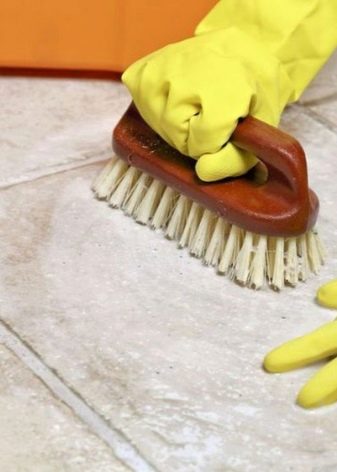
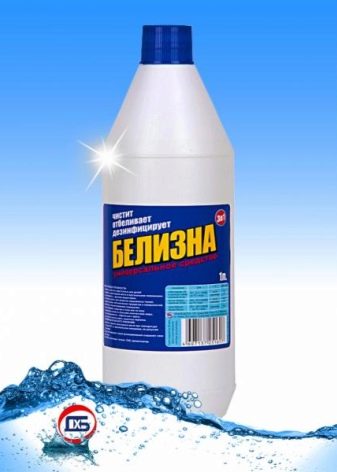
How to clean joints?
The joints that are located between the tiles can be cleaned using the following methods:
- powder for washing clothes;
- soda ash;
- cleaning agent for the kitchen (use a compound without a large abrasive).
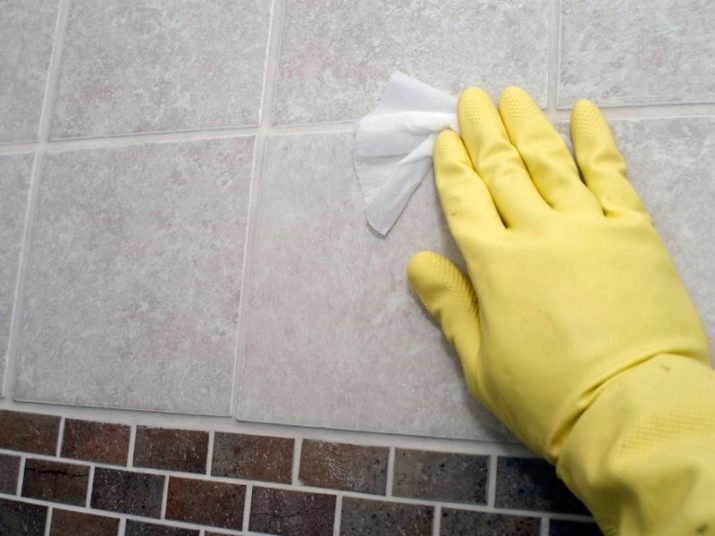
To clean the grooves without contamination, coat their surface with epoxy paint.
Joints are filled with a composition in which cement, resins, wax and glue are present. The ingredients form a rough and prone to dirt surface. You can wash them with "Whites." Cleaning is done with the tiles.
Toothbrush and toothpaste also clean the space between the tiles well. When the seams have dried, cover their surface with acrylic. Paint forms a film that can prevent future absorption of dirt.
If the seams cannot be cleaned, renew the surface. Wipe off the top coat with vinegar. Other components should not be used, as they can damage the tiles. Already on a dry gap, you can grout, following the instructions. Surplus needs to be removed. Cover the surface of the seams with acrylic paint.
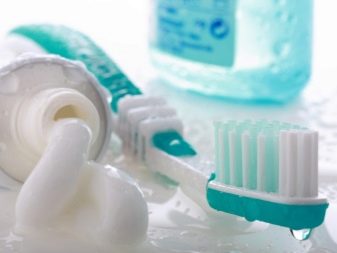
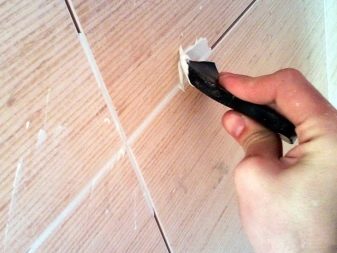
Remember that for walls it is recommended to use seams that are lighter than tiles by several tones. If you are updating the grout on the floor, then emphasize the joints with a darker pigment.
Surface features
Before removing contaminants from the tile, pay attention to the features of its surface. There are subtleties to working with each type. For example, matte tiles are best and easiest to clean with special compounds. If the pollution is heavy, to clean without streaks the surface will allow liquid ammonia. After it, you can use the emulsion for matt ceramics. A similar method will help keep the surface of the walls attractive and vibrant.
To make the matte surface shiny, apply polishing wax to dry ceramics. Many people prefer to save money and buy wax designed for car body treatment. It helps protect the walls of the bathroom, but is immediately washed out in contact with hot steam and water.
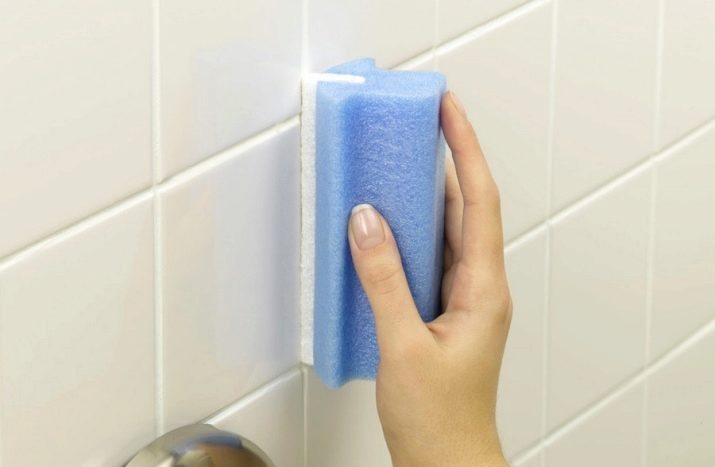
To wash embossed ceramic tiles at home, you can use specialized products for complex surfaces that are sold in stores. When cleaning rough ceramics or decor material, follow these guidelines:
- exclude aggressive agents or abrasives;
- Excellent reviews received Cillit Bang. It well cleans a rough surface from pollution;
- with the help of a steam generator you can remove all excess substances from the porous surface;
- For a more convenient washing process, use the Picobello mop.
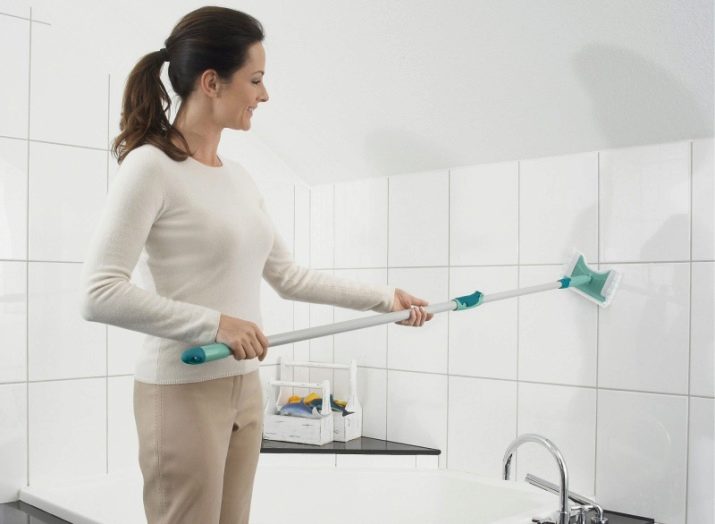
There are several ways in which you can easily wash the mosaic. Even if your ceramics has lost its attractive appearance, you can quickly transform the old tile by cleaning the grout. Choosing a similar method, consider the type of grout used in your bathroom and your capabilities.
When working with cement grout, start the process by removing the top coat and dust. New material can be applied only after processing the old surface. Use a special cleaner for this purpose, which is applied for five minutes. The washed seams should dry.
If the mosaic is joined with epoxy grout, remember that such a material is more dense and it is more difficult to remove. If the seams are contaminated by 70% or more, the tile will have to be removed and a new one laid out.

Using these rules, you can increase the efficiency of removing dirt in the bathroom. In your work, always consider what type of tile is in your home, since a porous, matte and glossy surface must be processed in different ways.
Care Tips
To tile in the bathroom for a long time retained its attractive appearance, it should be properly looked after. Follow these tile care guidelines:
- wipe the tile with a damp cloth in places where the tile is in contact with water;
- take care of the hood to prevent the formation of mold and fungus;
- once a week, clean the tiles in the bathroom;
- change the grout at the seams every few years to prevent mold.

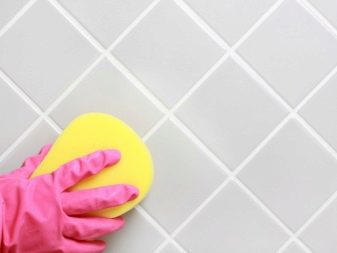
These recommendations will help to avoid the appearance of limescale, mold and other contaminants on the tiles in the bathroom.
See how to clean tiles in the bathroom to crystal clear in the next video.
